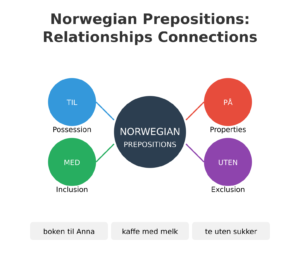Expressing emotions is an important aspect of human communication, as it allows us to connect with others on a deeper level. Language plays a crucial role in this process, as it provides us with the tools to convey our feelings and understand the emotions of others. In the Norwegian language, there are various phrases and expressions that can be used to express a wide range of emotions. Understanding and using these expressions can greatly enhance your ability to communicate effectively in Norwegian.
Norwegian language and culture are closely intertwined, and both play a significant role in shaping the way emotions are expressed. Norwegians are known for their reserved nature and tend to value modesty and understatement. This cultural influence is reflected in the language, where emotions are often expressed in a more subtle manner compared to other languages. However, this does not mean that Norwegians do not experience or express emotions; rather, they have their own unique ways of doing so.
Table of Contents
ToggleKey Takeaways
- Norwegian language has unique expressions for emotions that are important to learn.
- Common phrases for expressing happiness in Norwegian include “Jeg er så glad!” (I am so happy!) and “Det var fantastisk!” (That was fantastic!)
- To express sadness in Norwegian, phrases like “Jeg er lei meg” (I am sorry) and “Det gjør vondt” (It hurts) can be used.
- Norwegian phrases for showing gratitude include “Tusen takk” (Thank you very much) and “Jeg setter stor pris på det” (I appreciate it very much).
- Expressing love and affection in Norwegian can be done with phrases like “Jeg elsker deg” (I love you) and “Du betyr alt for meg” (You mean everything to me).
- To apologize in Norwegian, phrases like “Jeg beklager” (I apologize) and “Unnskyld meg” (Excuse me) can be used.
- Norwegian phrases for expressing anger include “Jeg er sint” (I am angry) and “Jeg er frustrert” (I am frustrated).
- Expressing frustration and disappointment in Norwegian can be done with phrases like “Jeg er skuffet” (I am disappointed) and “Dette er ikke bra” (This is not good).
- To show empathy in Norwegian, phrases like “Jeg forstår hvordan du føler deg” (I understand how you feel) and “Det må være vanskelig for deg” (That must be difficult for you) can be used.
- Mastering emotion expressions in Norwegian can help improve communication and understanding in personal and professional relationships.
Common Norwegian Phrases for Expressing Happiness
Happiness is a universal emotion that is cherished by people all over the world. In Norwegian, there are several phrases that can be used to express happiness and joy. One common phrase is “Gratulerer,” which means “congratulations.” This phrase is often used to express happiness and excitement for someone’s achievements or good fortune. Other congratulatory phrases include “Lykke til” (good luck) and “Godt jobbet” (well done).
To express personal joy or happiness, you can use the phrase “Jeg er så glad,” which translates to “I am so happy.” This expression can be used in various contexts, such as when you receive good news or when you are simply feeling joyful. Other expressions of joy include “Jeg er overlykkelig” (I am overjoyed) and “Jeg er henrykt” (I am delighted).
When someone does something kind or helpful for you, it is important to express your gratitude. In Norwegian, there are several ways to say thank you, such as “Tusen takk” (a thousand thanks) and “Takk så mye” (thank you very much). These phrases can be used in both formal and informal settings to show appreciation and gratitude.
How to Express Sadness in Norwegian
Sadness is a natural emotion that everyone experiences at some point in their lives. In Norwegian, there are various phrases that can be used to express sadness and sorrow. One common phrase is “Jeg er lei meg,” which means “I am sorry” or “I am sad.” This expression can be used when you want to convey your feelings of sadness or apologize for something.
When offering condolences, the phrase “Kondolerer” is commonly used. This phrase is similar to the English expression “I offer my condolences” and is used to express sympathy and support during times of loss or grief. Other condolences include “Jeg føler med deg” (I feel for you) and “Mine tanker er med deg” (My thoughts are with you).
To express sympathy or acknowledge someone else’s sadness, you can use the phrase “Det er trist,” which means “It is sad.” This expression can be used to show empathy and understanding towards someone who is going through a difficult time. Other ways to express sympathy include “Jeg forstår hvordan du føler deg” (I understand how you feel) and “Jeg er her for deg” (I am here for you).
Norwegian Phrases for Showing Gratitude
Gratitude is an important emotion that allows us to acknowledge and appreciate the kindness of others. In Norwegian, there are several phrases that can be used to show gratitude and appreciation. One common phrase is “Takk skal du ha,” which translates to “Thank you very much.” This expression can be used in various situations to express gratitude for someone’s help or kindness.
Another way to show appreciation is by using the phrase “Jeg setter stor pris på det,” which means “I greatly appreciate it.” This expression can be used when you want to convey a deeper level of gratitude and emphasize the importance of someone’s actions or words. Other expressions of appreciation include “Jeg er veldig takknemlig” (I am very grateful) and “Jeg er så glad for hjelpen” (I am so grateful for the help).
In addition to verbal expressions of gratitude, there are also non-verbal ways to show appreciation in Norwegian. One common gesture is to give a small gift or token of appreciation, such as flowers or a handwritten note. These gestures can be accompanied by phrases like “Tusen takk for gaven” (Thank you so much for the gift) or “Jeg setter pris på oppmerksomheten” (I appreciate the attention).
Expressing Love and Affection in Norwegian
Love and affection are powerful emotions that can bring people closer together. In Norwegian, there are several ways to express these feelings towards someone. One of the most common phrases is “Jeg elsker deg,” which means “I love you.” This expression is used to convey deep affection and love towards a romantic partner or a close family member.
Another way to express affection is by using the phrase “Du betyr alt for meg,” which translates to “You mean everything to me.” This expression can be used to convey the importance and significance of someone in your life. Other expressions of affection include “Jeg er glad i deg” (I am fond of you) and “Du er mitt alt” (You are my everything).
In addition to verbal expressions, physical gestures can also be used to show love and affection in Norwegian. One common gesture is a hug, which is called “klem” in Norwegian. Giving someone a hug can be a powerful way to express your love and affection towards them. Other physical expressions of love include holding hands, kissing, and cuddling.
How to Apologize in Norwegian
Apologizing is an important skill that allows us to take responsibility for our actions and repair damaged relationships. In Norwegian, there are several ways to apologize and express regret. One common phrase is “Unnskyld,” which means “I’m sorry” or “Excuse me.” This expression can be used in various situations, such as when you make a mistake or accidentally bump into someone.
Another way to apologize is by using the phrase “Jeg beklager,” which translates to “I apologize.” This expression can be used when you want to convey a deeper level of regret and acknowledge the impact of your actions. Other expressions of regret include “Det var min feil” (It was my fault) and “Jeg skulle ønske jeg kunne gjøre det om igjen” (I wish I could do it over).
Taking responsibility for your actions is an important part of apologizing. In Norwegian, you can use the phrase “Det var min feil” (It was my fault) to acknowledge your role in a situation and express your willingness to make amends. Other ways to take responsibility include offering to fix the problem or make things right, such as saying “La meg ordne opp i dette” (Let me fix this) or “La meg gjøre det godt igjen” (Let me make it up to you).
Norwegian Phrases for Expressing Anger
Anger is a powerful emotion that can arise in response to various situations. In Norwegian, there are several phrases that can be used to express anger and frustration. One common phrase is “Jeg er sint,” which means “I am angry.” This expression can be used to convey your feelings of anger and frustration towards a person or a situation.
Another way to express frustration is by using the phrase “Jeg er irritert,” which translates to “I am annoyed.” This expression can be used when you are feeling irritated or bothered by something. Other expressions of frustration include “Dette er uakseptabelt” (This is unacceptable) and “Jeg er lei av dette” (I am tired of this).
When expressing disapproval or disagreement, you can use the phrase “Dette er ikke bra nok,” which means “This is not good enough.” This expression can be used to convey your dissatisfaction with a situation or an outcome. Other ways to express disapproval include saying “Jeg er ikke enig” (I disagree) or “Jeg kan ikke akseptere dette” (I cannot accept this).
Expressing Frustration and Disappointment in Norwegian
Frustration and disappointment are common emotions that can arise when our expectations are not met. In Norwegian, there are several phrases that can be used to express these feelings. One common phrase is “Jeg er skuffet,” which means “I am disappointed.” This expression can be used to convey your feelings of disappointment towards a person or a situation.
When something does not meet your expectations, you can use the phrase “Dette er ikke bra nok,” which translates to “This is not good enough.” This expression can be used to express your dissatisfaction and convey that the outcome or performance falls short of what was expected. Other expressions of dissatisfaction include “Jeg forventet mer” (I expected more) and “Dette er ikke det jeg hadde håpet på” (This is not what I had hoped for).
To express frustration, you can use the phrase “Jeg er lei meg for dette,” which means “I am sorry for this” or “I am frustrated by this.” This expression can be used to convey your feelings of frustration and apologize for any inconvenience or disappointment caused. Other ways to express frustration include saying “Dette er ikke slik det skal være” (This is not how it should be) or “Jeg er frustrert over denne situasjonen” (I am frustrated with this situation).
How to Show Empathy in Norwegian
Empathy is the ability to understand and share the feelings of others. In Norwegian, there are several phrases that can be used to show empathy and offer support. One common phrase is “Jeg forstår hvordan du føler deg,” which means “I understand how you feel.” This expression can be used to convey your understanding and empathy towards someone who is going through a difficult time.
Another way to show empathy is by using the phrase “Det må være vanskelig for deg,” which translates to “It must be difficult for you.” This expression can be used to acknowledge someone’s struggles and offer support. Other expressions of understanding include “Jeg vet det er tøft” (I know it is tough) and “Jeg kan forestille meg hvor vanskelig dette er for deg” (I can imagine how difficult this is for you).
To offer support, you can use the phrase “Jeg er her for deg,” which means “I am here for you.” This expression can be used to convey your willingness to listen, provide comfort, or help in any way you can. Other ways to offer support include saying “Du kan alltid komme til meg hvis du trenger noen å snakke med” (You can always come to me if you need someone to talk to) or “Jeg støtter deg uansett hva” (I support you no matter what).
Mastering Emotion Expressions in Norwegian
Mastering the art of expressing emotions in Norwegian can greatly enhance your ability to communicate effectively and connect with others on a deeper level. In this article, we have explored various phrases and expressions for expressing happiness, sadness, gratitude, love and affection, apologies, anger, frustration, disappointment, and empathy.
By practicing and using these emotion expressions in your everyday conversations, you can become more fluent and confident in expressing your feelings in Norwegian. Remember that language and culture are closely intertwined, so it is important to understand the cultural context in which these expressions are used.
As you continue to explore the Norwegian language and culture, don’t be afraid to experiment with different phrases and expressions. Emotions are a universal language, and by mastering the art of expressing them in Norwegian, you can deepen your understanding of the language and forge meaningful connections with native speakers. So go ahead, embrace your emotions, and continue on your journey of learning Norwegian!









